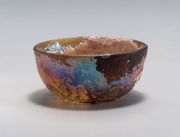Devitrification
Description
A microscopic change from an amorphous, anisotropic material to a crystalline, isotropic substance. The term 'devitrification' is usually applied to man-made glass or ceramic glazes but may also apply to natural glass minerals such as obsidian. Devitrification occurs when the normally amorphous form of glass may slowly or rapidly becomes crystalline resulting in lost transparency and cohesive structure. Rapid devitrification may occur when molten glass is cooled too slowly thus allowing components to separate and crystallize. Slow devitrification may occur in moist soils or similar environments where alkaline components leach out, thus allowing the remaining silica-rich material to crystallize. Devitrified glass or ceramic glazes have decreased transparency and may appear to have a whitish haze or an iridescent sheen.
Synonyms and Related Terms
glass sugaring; desvitrificación (Esp.); dévitrification (Fr.); devetrificazione (It.); devitrificatie (Ned.); desvitrificação (Port.)
Resources and Citations
- Richard S. Lewis, Hawley's Condensed Chemical Dictionary, Van Nostrand Reinhold, New York, 10th ed., 1993
- ASTM, Standard Terminology Relating to Thermophysical Properties, Annual Book of ASTM Standards, Section 6, Paints, Related Coatings and Aromatics, ASTM, E1142, 695-696, Jul-94
- Walter C. McCrone, John Gustave Delly, The Particle Atlas, W. McCrone Associates, Chicago, IV, 1972
- Random House, Webster's Encyclopedic Unabridged Dictionary of the English Language, Grammercy Book, New York, 1997
- The American Heritage Dictionary or Encarta, via Microsoft Bookshelf 98, Microsoft Corp., 1998
